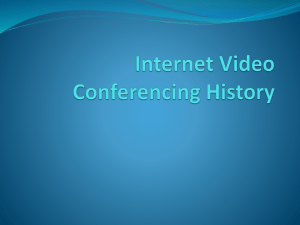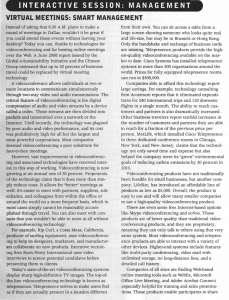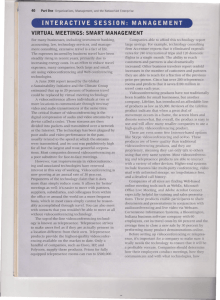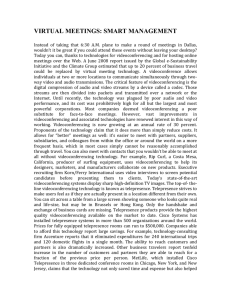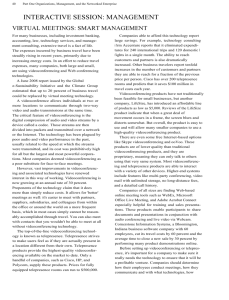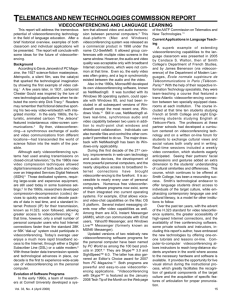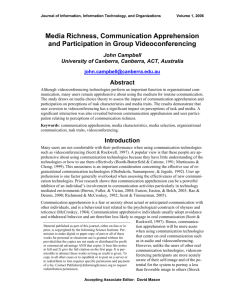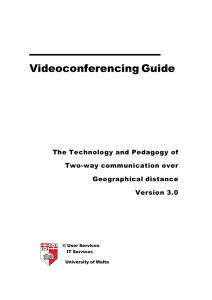Plan for Sustainability and Savings v006 - IFAS
advertisement
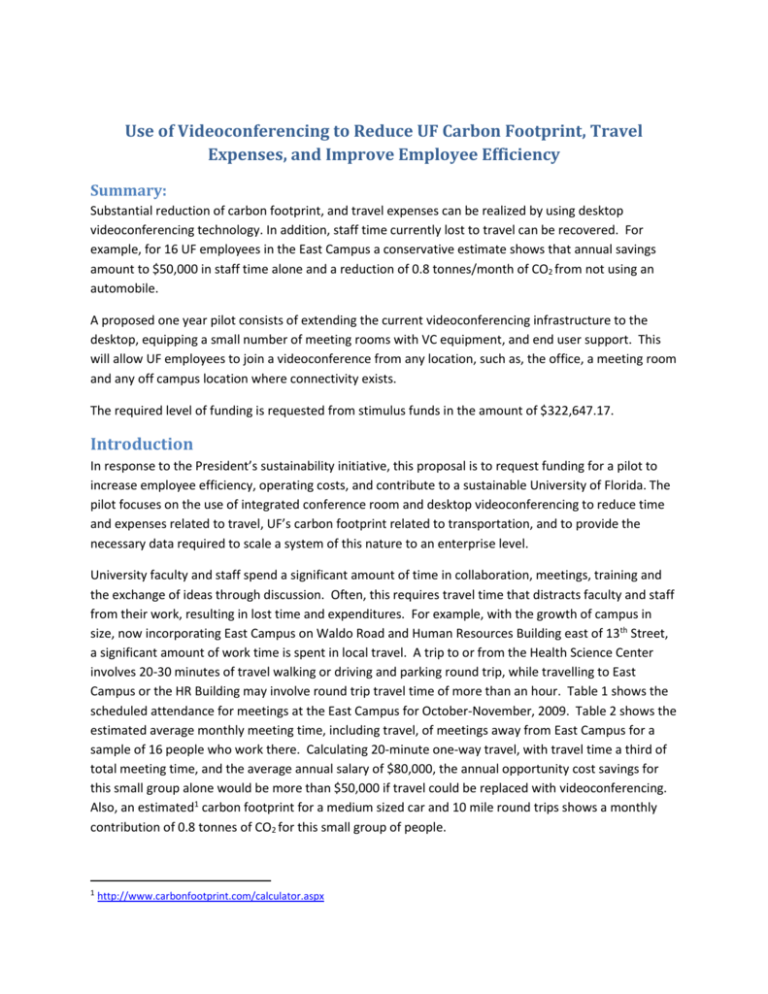
Use of Videoconferencing to Reduce UF Carbon Footprint, Travel Expenses, and Improve Employee Efficiency Summary: Substantial reduction of carbon footprint, and travel expenses can be realized by using desktop videoconferencing technology. In addition, staff time currently lost to travel can be recovered. For example, for 16 UF employees in the East Campus a conservative estimate shows that annual savings amount to $50,000 in staff time alone and a reduction of 0.8 tonnes/month of CO2 from not using an automobile. A proposed one year pilot consists of extending the current videoconferencing infrastructure to the desktop, equipping a small number of meeting rooms with VC equipment, and end user support. This will allow UF employees to join a videoconference from any location, such as, the office, a meeting room and any off campus location where connectivity exists. The required level of funding is requested from stimulus funds in the amount of $322,647.17. Introduction In response to the President’s sustainability initiative, this proposal is to request funding for a pilot to increase employee efficiency, operating costs, and contribute to a sustainable University of Florida. The pilot focuses on the use of integrated conference room and desktop videoconferencing to reduce time and expenses related to travel, UF’s carbon footprint related to transportation, and to provide the necessary data required to scale a system of this nature to an enterprise level. University faculty and staff spend a significant amount of time in collaboration, meetings, training and the exchange of ideas through discussion. Often, this requires travel time that distracts faculty and staff from their work, resulting in lost time and expenditures. For example, with the growth of campus in size, now incorporating East Campus on Waldo Road and Human Resources Building east of 13th Street, a significant amount of work time is spent in local travel. A trip to or from the Health Science Center involves 20-30 minutes of travel walking or driving and parking round trip, while travelling to East Campus or the HR Building may involve round trip travel time of more than an hour. Table 1 shows the scheduled attendance for meetings at the East Campus for October-November, 2009. Table 2 shows the estimated average monthly meeting time, including travel, of meetings away from East Campus for a sample of 16 people who work there. Calculating 20-minute one-way travel, with travel time a third of total meeting time, and the average annual salary of $80,000, the annual opportunity cost savings for this small group alone would be more than $50,000 if travel could be replaced with videoconferencing. Also, an estimated1 carbon footprint for a medium sized car and 10 mile round trips shows a monthly contribution of 0.8 tonnes of CO2 for this small group of people. 1 http://www.carbonfootprint.com/calculator.aspx Modern computers and local audio/video devices (webcams), coupled with available software applications, offer the option of videoconferencing from the work desk, bypassing the need for travel, and yet provide the opportunity for interpersonal communication nearly equivalent to meeting in person. This technology can also be used when travelling off campus using a conventional laptop with the appropriate software and an Internet connection. IFAS, HSC and AT have embraced videoconferencing technology for communication with research centers, county offices across the state, clinics, hospitals and peer institutions internationally. Implementing this desktop videoconferencing widely across UF would further significantly decrease productivity lost to travel between campus and other locations. In addition, there would be a noteworthy reduction in carbon emissions from vehicular travel. Proposal Use stimulus funds to supplement the existing video conferencing infrastructure to: 1) Integrate the existing OC2 desktop videoconferencing software (currently available to all faculty) into the existing videoconferencing infrastructure. 2) Upgrade the existing videoconferencing infrastructure to support OC. 3) Evaluate the use of desktop videoconferencing as a substitute for face to face meetings. 4) Estimate UF employee time savings and carbon footprint reduction. 5) Demonstrate and assess the potential value to UF of desktop videoconferencing. All faculty that have a webcam3, and have installed the available OC license, would be able to join a conference. In addition six videoconferencing rooms would be equipped/upgraded to hold online meetings at Bridges, HR, AT/HUB, Tigert and CITT/Turlington. Support and training would be made available through AT for those facilitating meetings or conducting e-learning classes. In addition, free online training is available from Microsoft. The proposal includes: 1) A new video bridge system to replace the current aging system and to provide connectivity between OC and current existing campus videoconferencing systems, an environment not currently supported. 2) E-Cal software license required to integrate services. 3) Edge service to connect the system to external clients and peers. 4) Polycom CX5000 units (360o video conferencing cameras). 5) Miscellaneous audiovisual equipment to upgrade meeting rooms. 6) A half time position for support and training. The cost of the one year pilot is $322,647.17. Budget details are shown in Table 3. 2 Microsoft Office Communicator Individual departments would be expected to purchase Webcams for faculty and staff who would use them; current cost is between $40 and $80 each. Additional conference room units may be desirable, and would also be funded by individual departments. 3 Table 1 Scheduled Attendance at Meetings in East Campus October November Total Sunshine Skyway 103 126 229 Venetian Causeway 108 95 203 Buckman Bridge 10 9 19 Dames Point 51 55 106 Bridge of Lions 39 33 72 311 318 629 Total Table 2 Estimated Average Time2 Employee Hrs/Month Palmer, Lissa 8 McDonald, Andrew 12 Shivers, James 8 Drake, Larry 20 Noffsinger,Bill 12 Smith,Cathy 8 Gruber,Dave 88 Hay-Roe,Keith 16 Gale,Tracy 10 Catledge,Lee 24 Hall, Mikki 24 Cason,Spencer 32 Williamson,Paul 24 Chong-You,Nigel 40 Kutch,FJ 24 Solomon,Stephan 4 Total 354 2 Using an estimated 20 minutes for travel one way and an average salary of $80,000 including benefits results in a cost of more than $50,000 for the group of employees shown above. Table 3 Budget Site license for E-CAL software $107,881.92 New Tandberg video bridge $115,007.00 Six Polycom CX5000 conference table video camera units 24,692.04 Six Dell computers for CX5000 units 3,851.04 Six projectors (some rooms may already have projectors) 9,900.00 Six screens (some rooms may already have screens) 600.00 Edge Service to connect OC externally (Hardware and software) 15,500.00 $45,000.00 0.5 Support FTE Total $322,647.17

